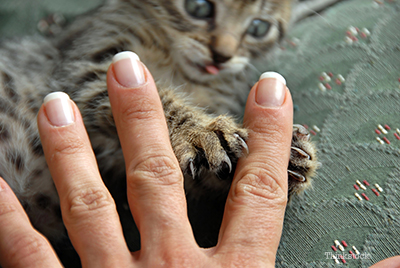
If you’ve never heard of bartonella, you are not alone. Bartonella is a genus of bacteria that cause disease in people and animals. While you may not have heard of bartonella, you may be familiar with at least one of the diseases caused by this bacterium: Cat Scratch Disease. Cat Scratch Disease is caused by the bacterium Bartonella henselae. According to the CDC, Cat Scratch Disease affects 9.3 per 100,000 people per year in the US (approximately 29,000 annually based on our population of 316 million), most frequently children younger than 15 years of age. Besides Cat Scratch Disease, other bartonella species are responsible for Trench Fever, Bacillary Angiomatosis and Carrion’s Disease in people.
How is Cat Scratch Disease transmitted?
According to the CDC, 41% of healthy cats harbor Bartonella henselae. Bartonella henselae is also more common in young cats and strays. Cats typically become infected when bitten by an infected flea. Though less common, cats can also become infected when exposed to infected blood, such as from a blood transfusion or during a cat fight. People get Cat Scratch Disease when scratched or bitten by an infected cat, typically a kitten.
Signs of Cat Scratch Disease
Cats infected with Bartonella henselae are typically asymptomatic, meaning they do not appear sick. The signs and symptoms of Cat Scratch Disease in humans vary widely. Many people show no symptoms at all while others may have fever; malaise; chills and enlarged, painful lymph nodes.
Diagnosis of Cat Scratch Disease
If a cat or person is bitten or scratched by a cat and develops some of the common symptoms of Cat Scratch Disease, the doctor may recommend serologic testing to determine if there was exposure to Bartonella henselae.Treatment of Cat Scratch Disease
Treatment of Cat Scratch Disease depends on the severity and the immune status of the afflicted patient. Since most cases are self-limited (self-resolving), conservative treatment will likely be recommended. Antibiotics are reserved for severe and systemic disease. In addition, immunocompromised patients require a longer antibiotic course.
Prevention of Cat Scratch Disease
As with all diseases, prevention is the best treatment. The best way to prevent Cat Scratch Disease is to avoid getting scratched or bitten, which means no rough play with rambunctious kittens. In addition, keep your cats indoors and on year-round flea control to decrease exposure to infected fleas carrying Bartonella henselae. Enforce hand washing with soap after playing with cats, and avoid contact with stray cats. Immunocompromised people should take additional precautions, and according to the CDC, they should avoid owning kittens.
Questions for your veterinarian
- What flea preventatives do you recommend for my pets?
- Do my indoor cats need flea preventatives?
- I have a new kitten, do I need to do anything special?
Learn more about feline bartonella: beyond cat scratch disease.
If you have any questions or concerns, you should always visit or call your veterinarian -- they are your best resource to ensure the health and well-being of your pets.
